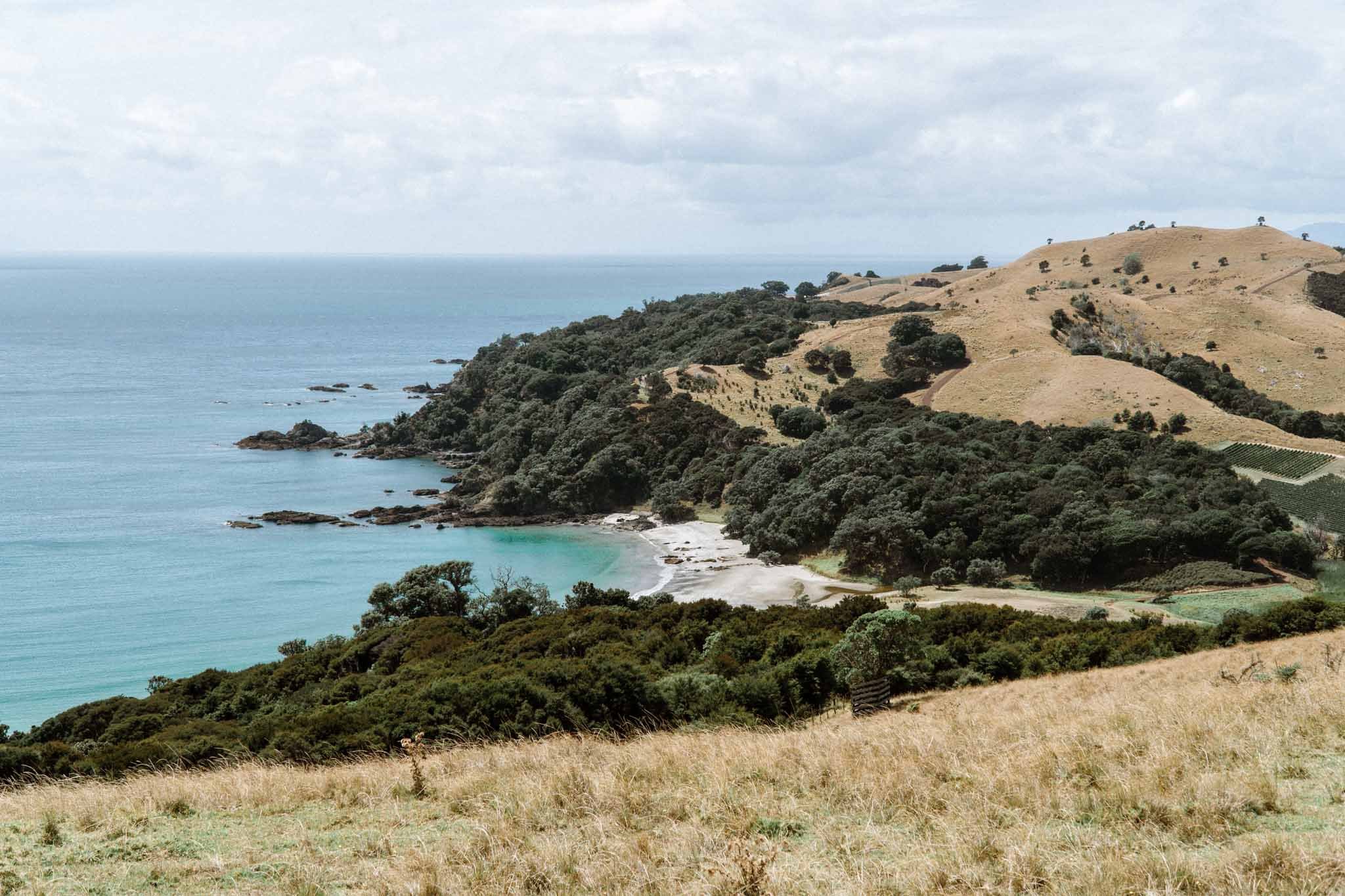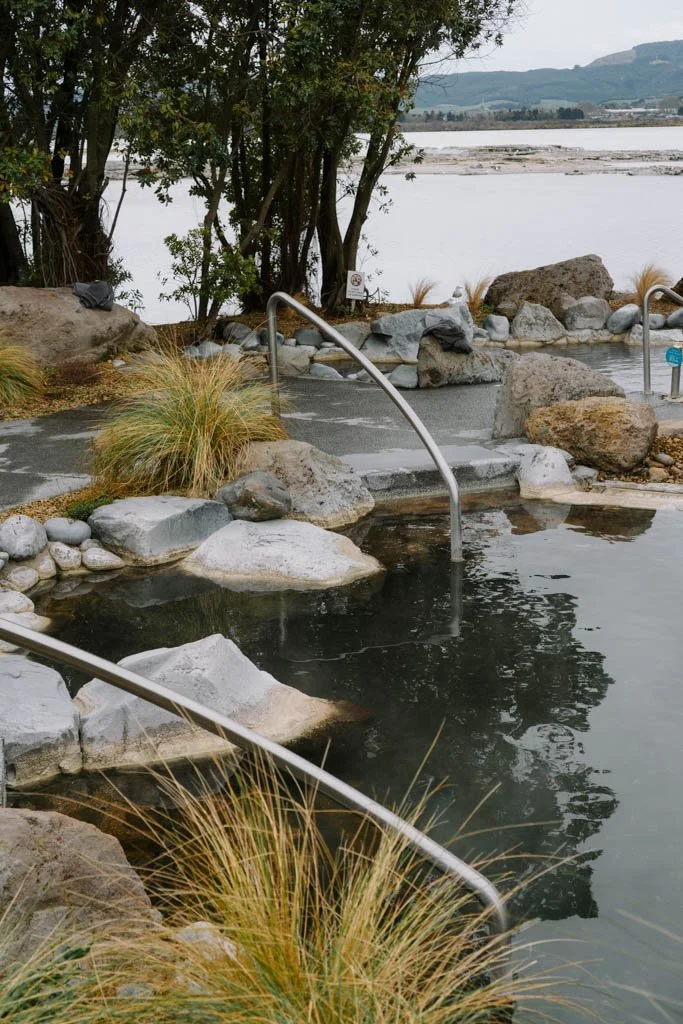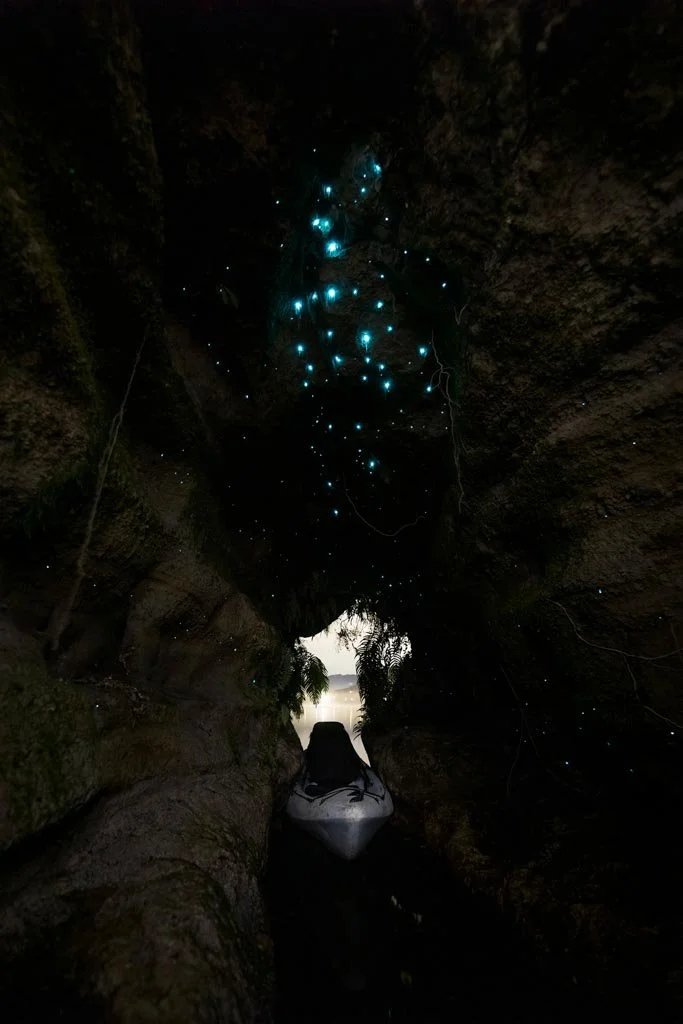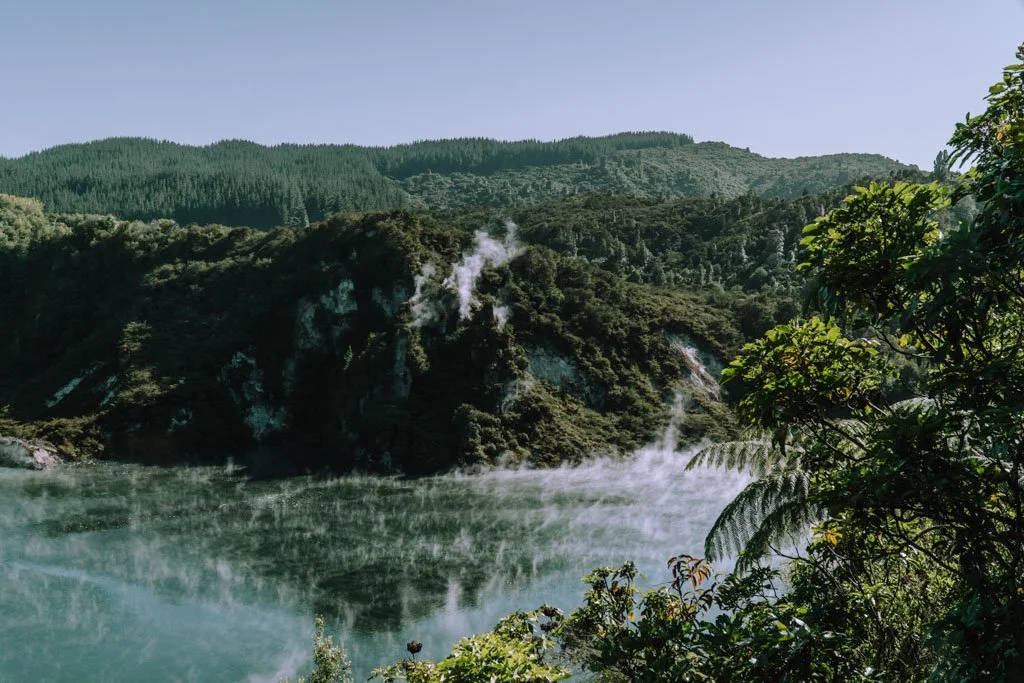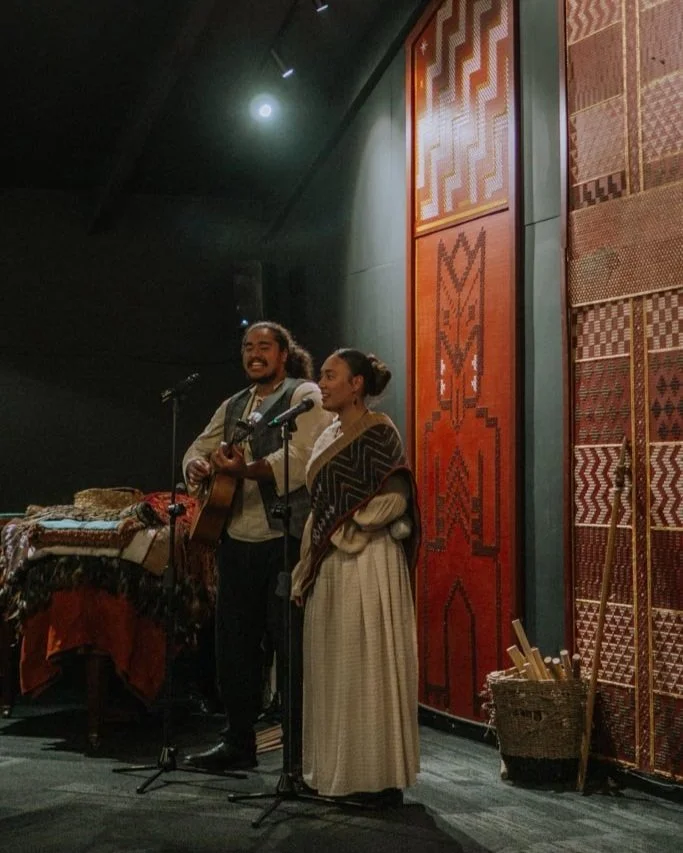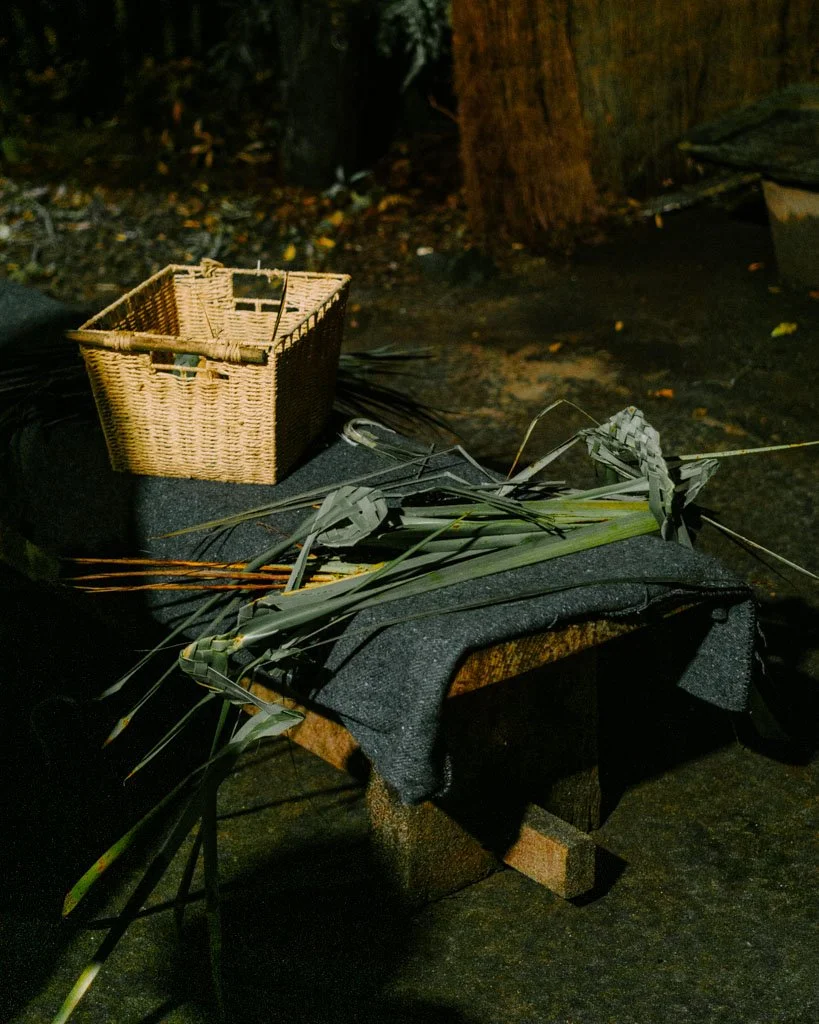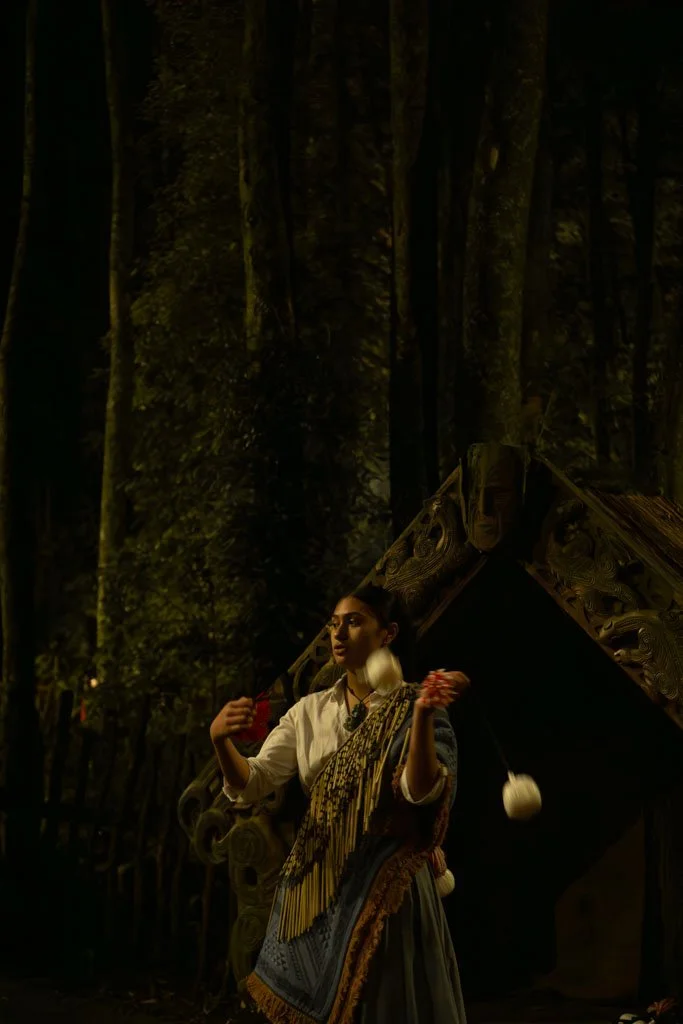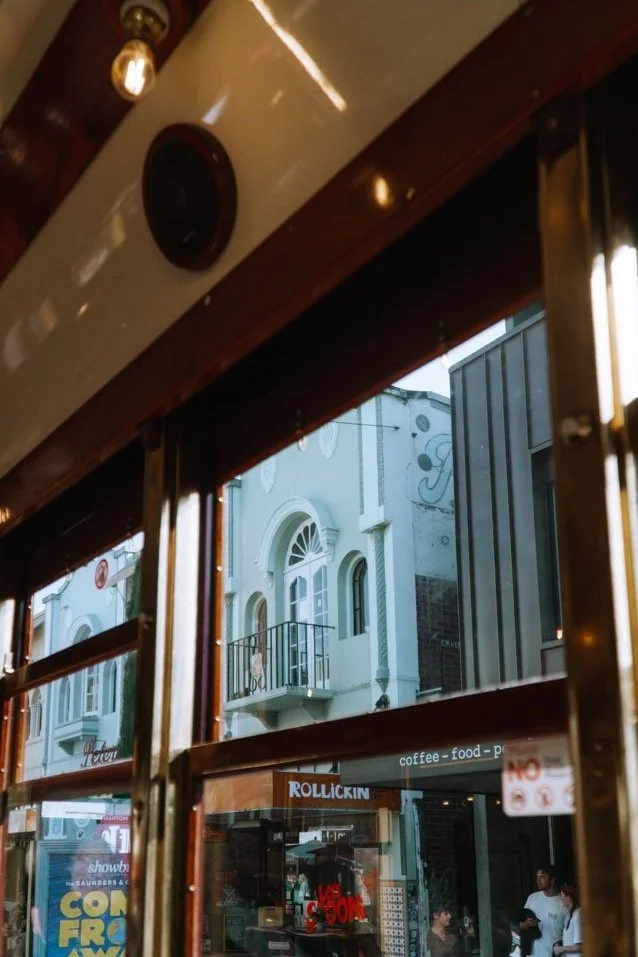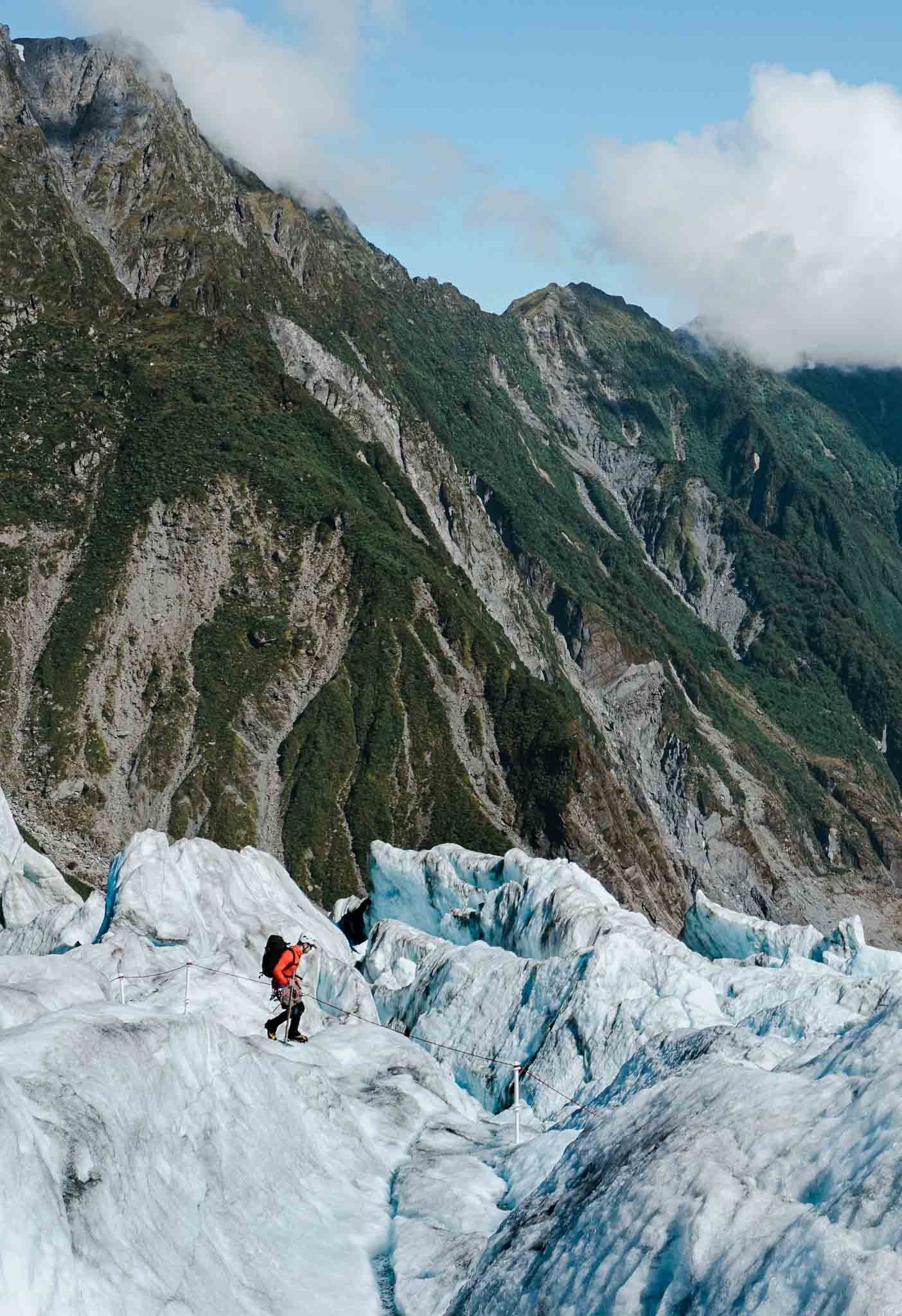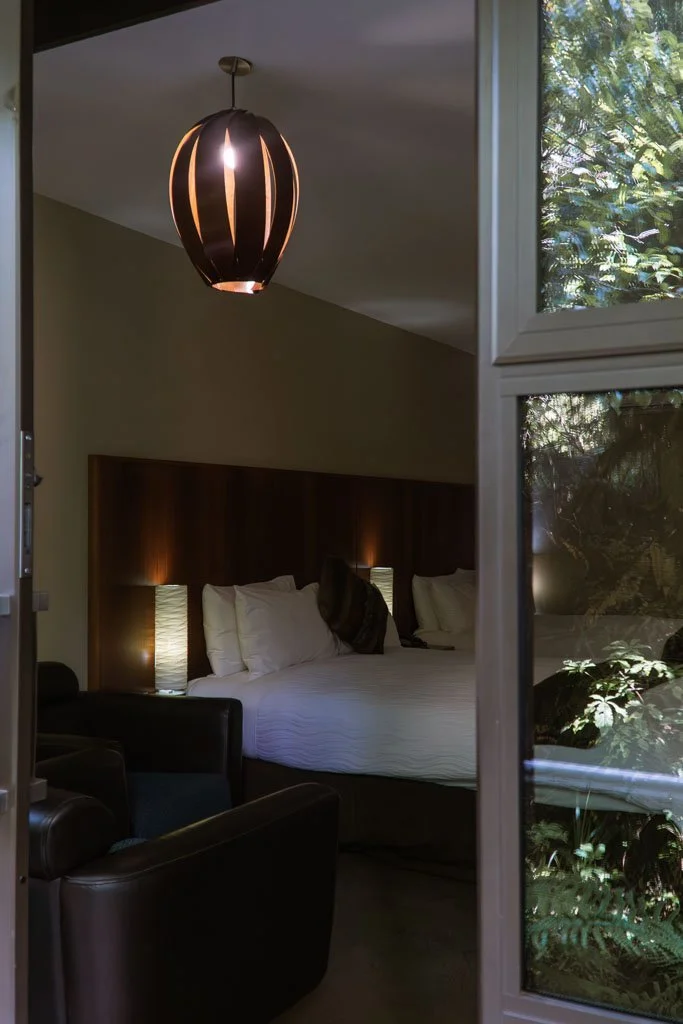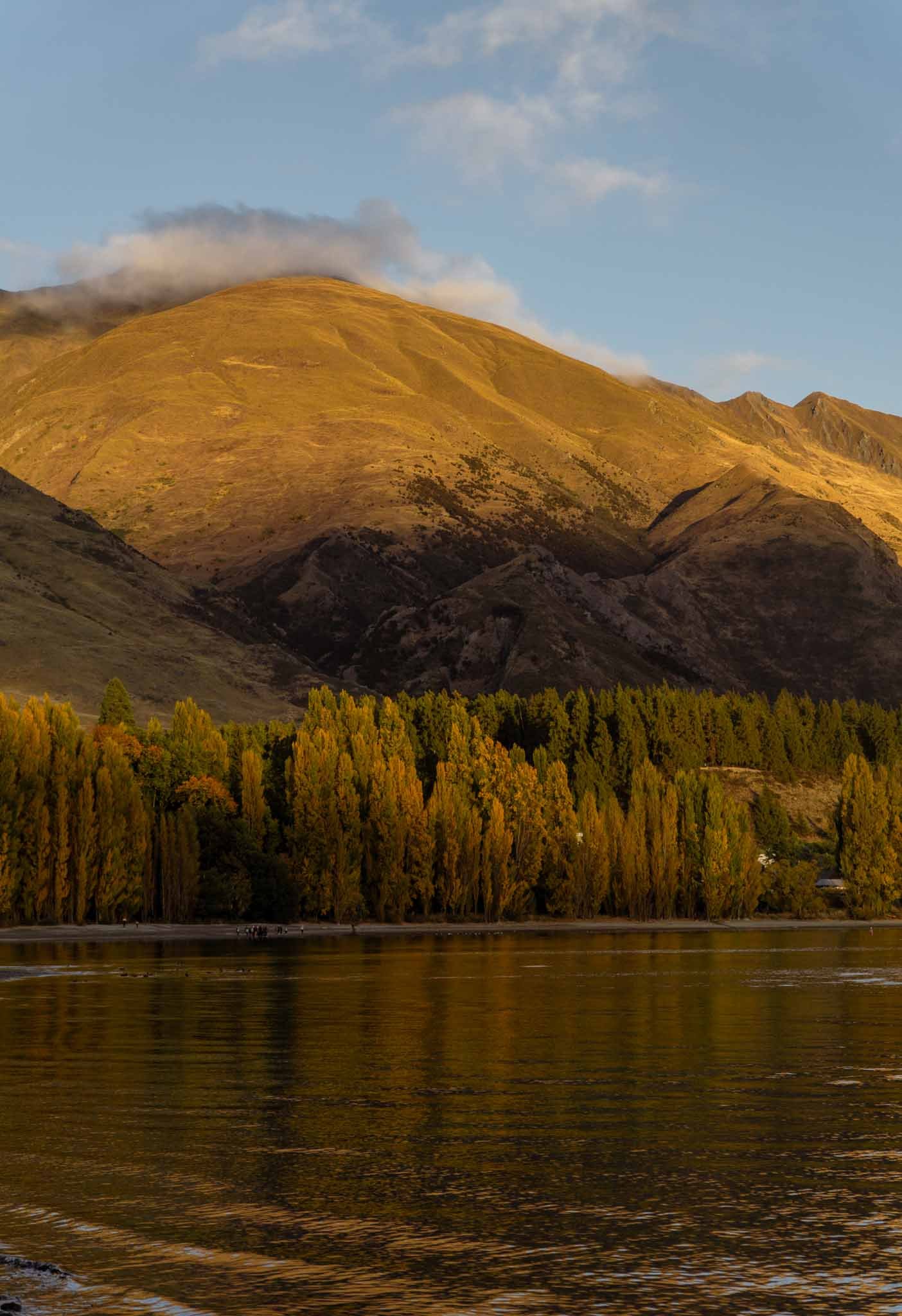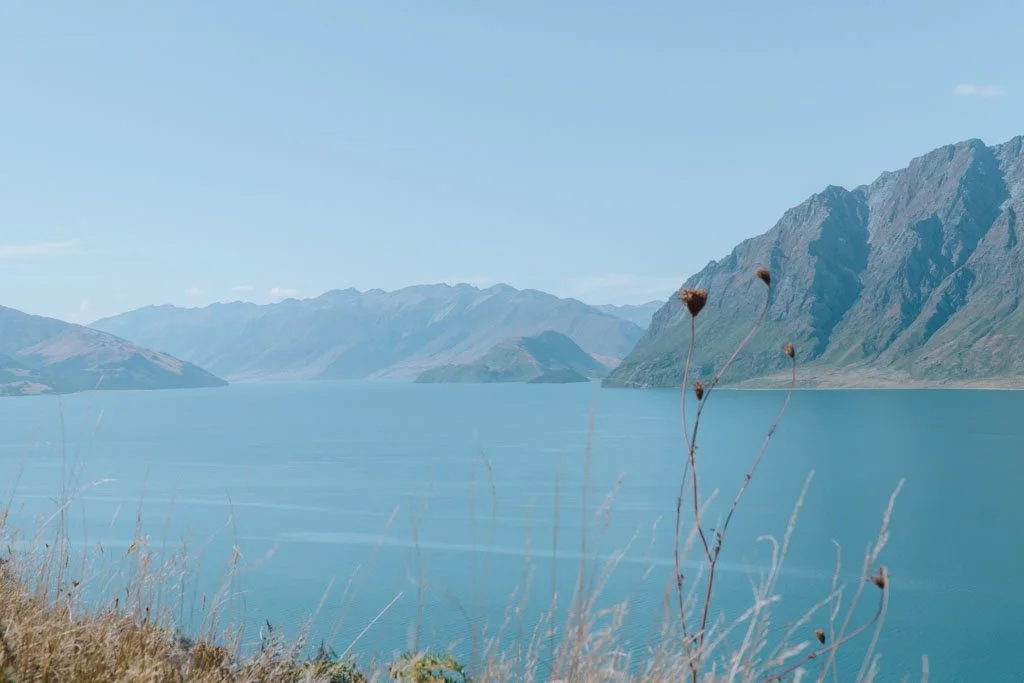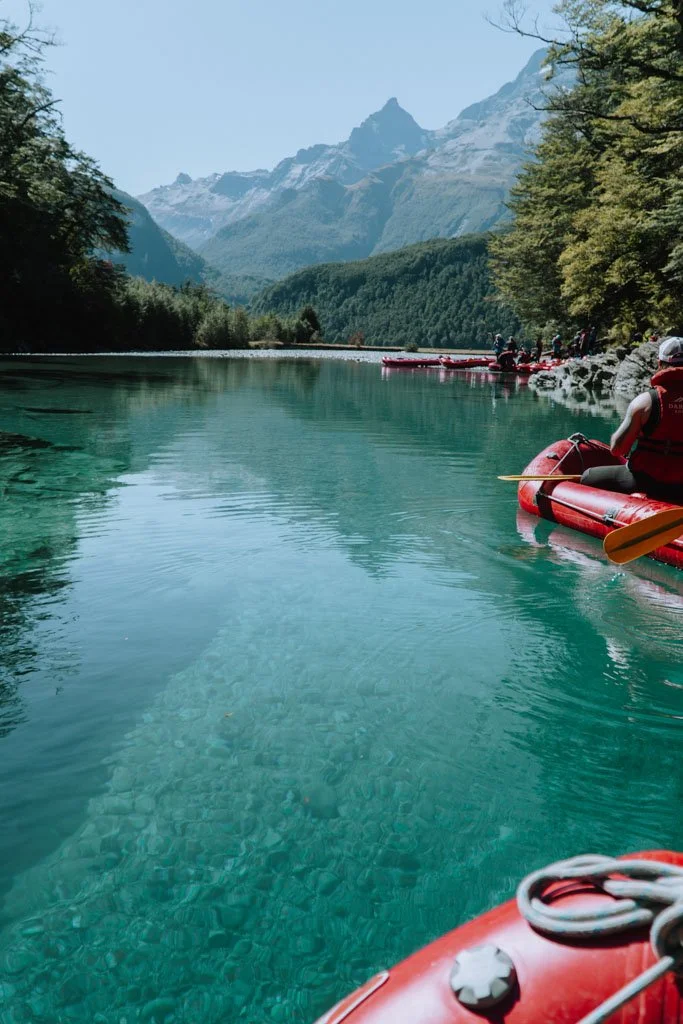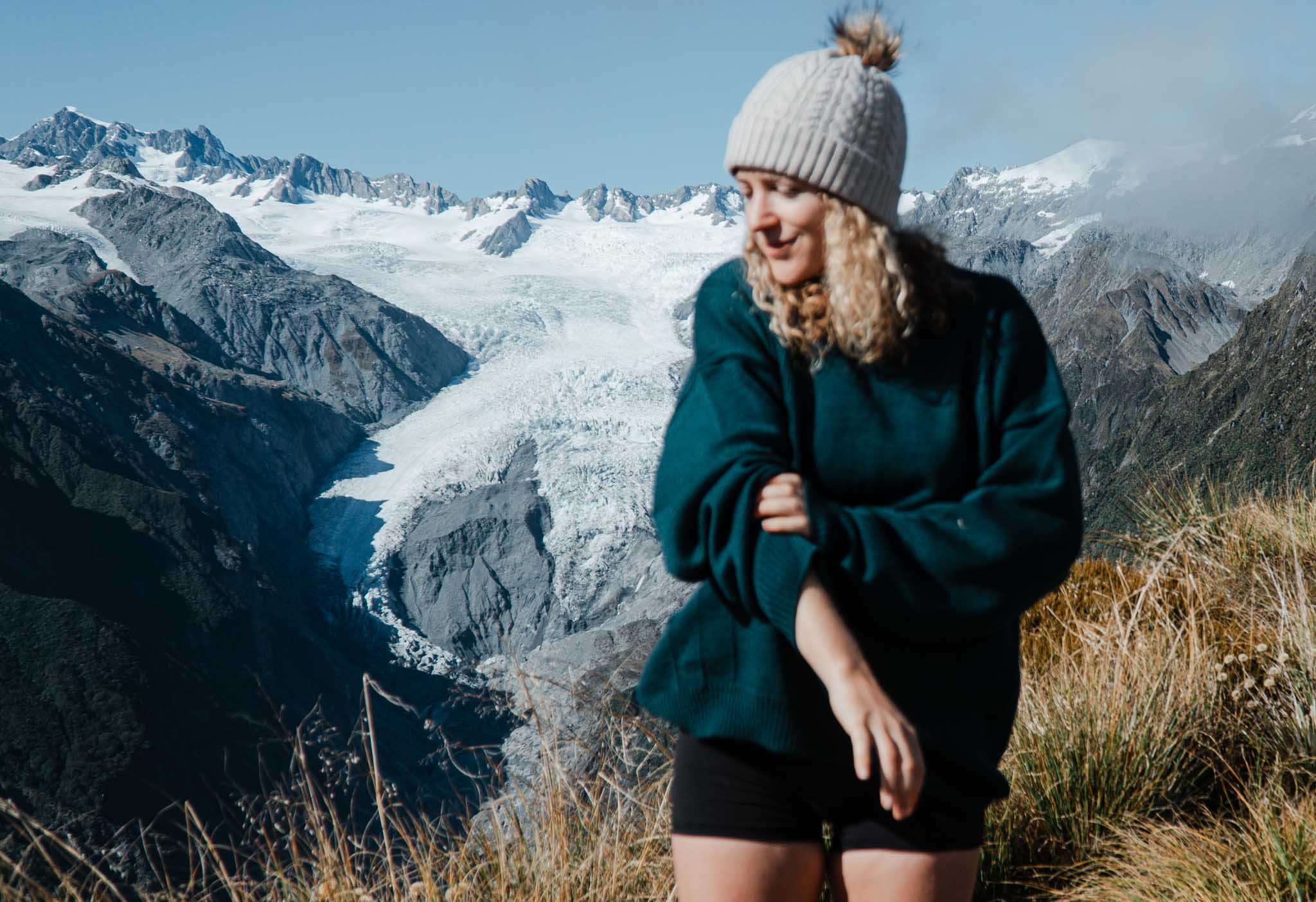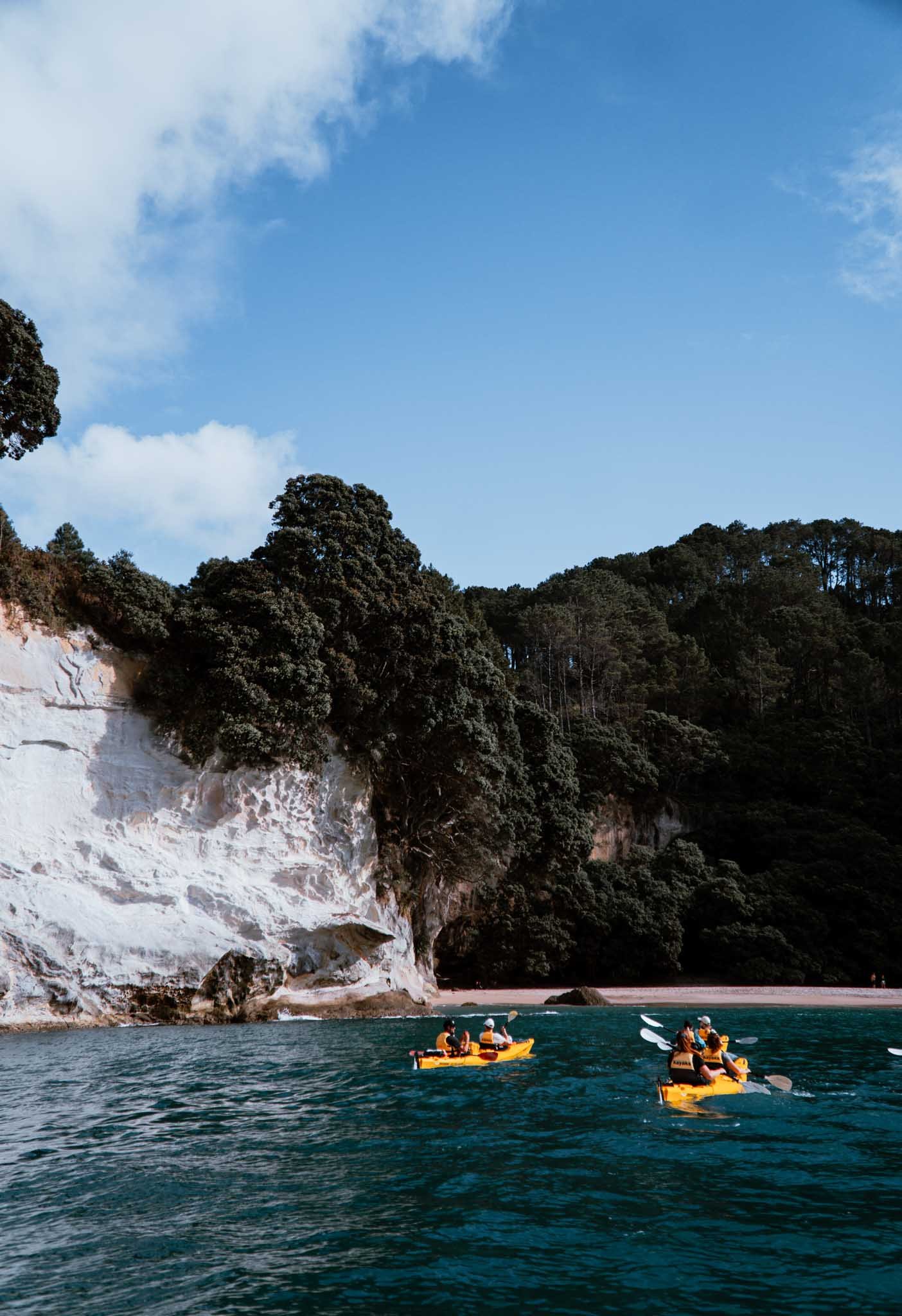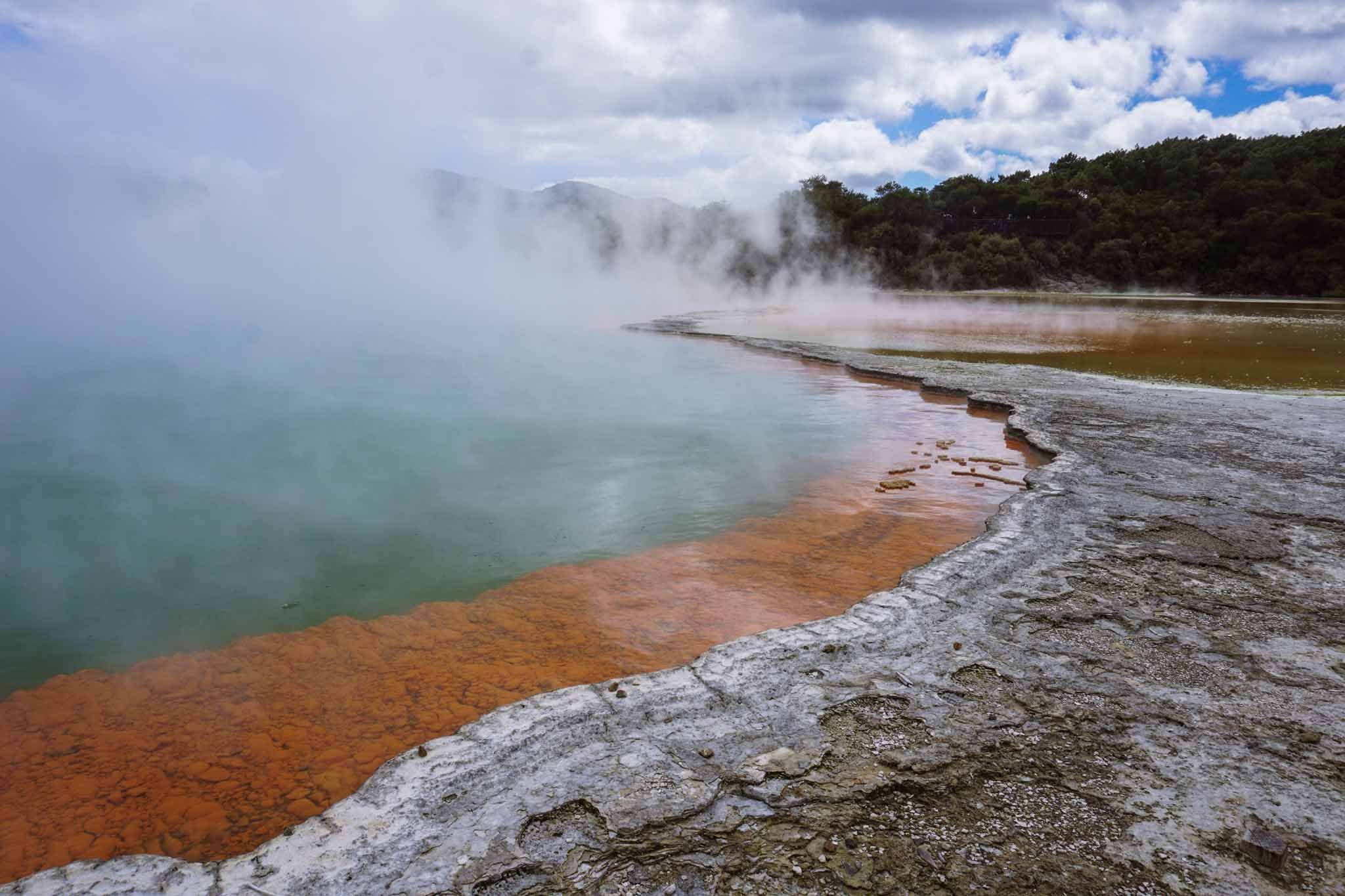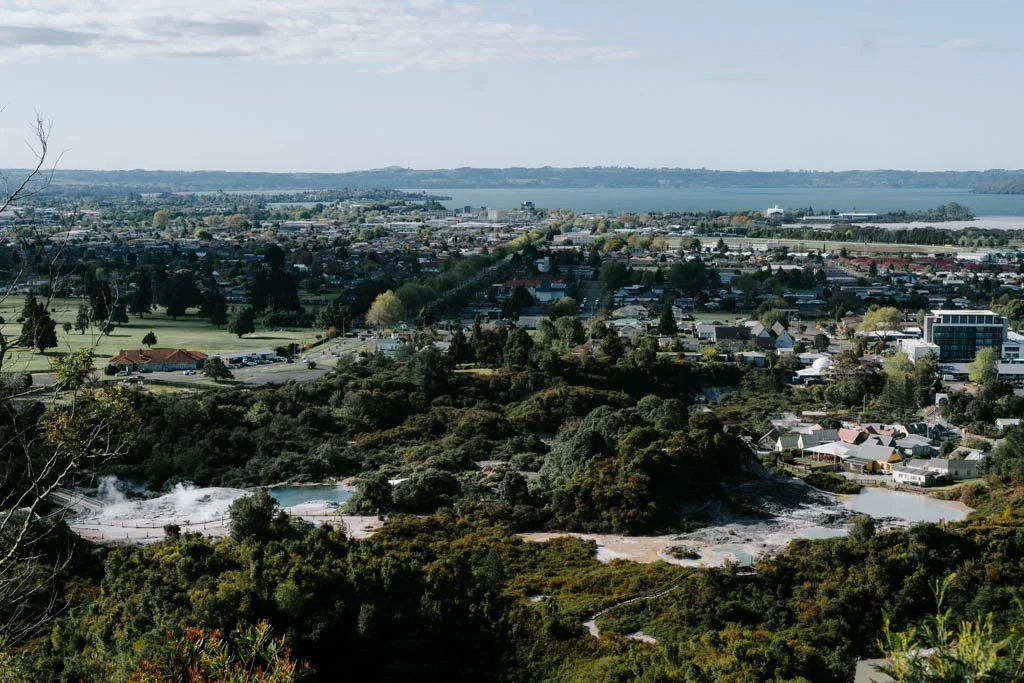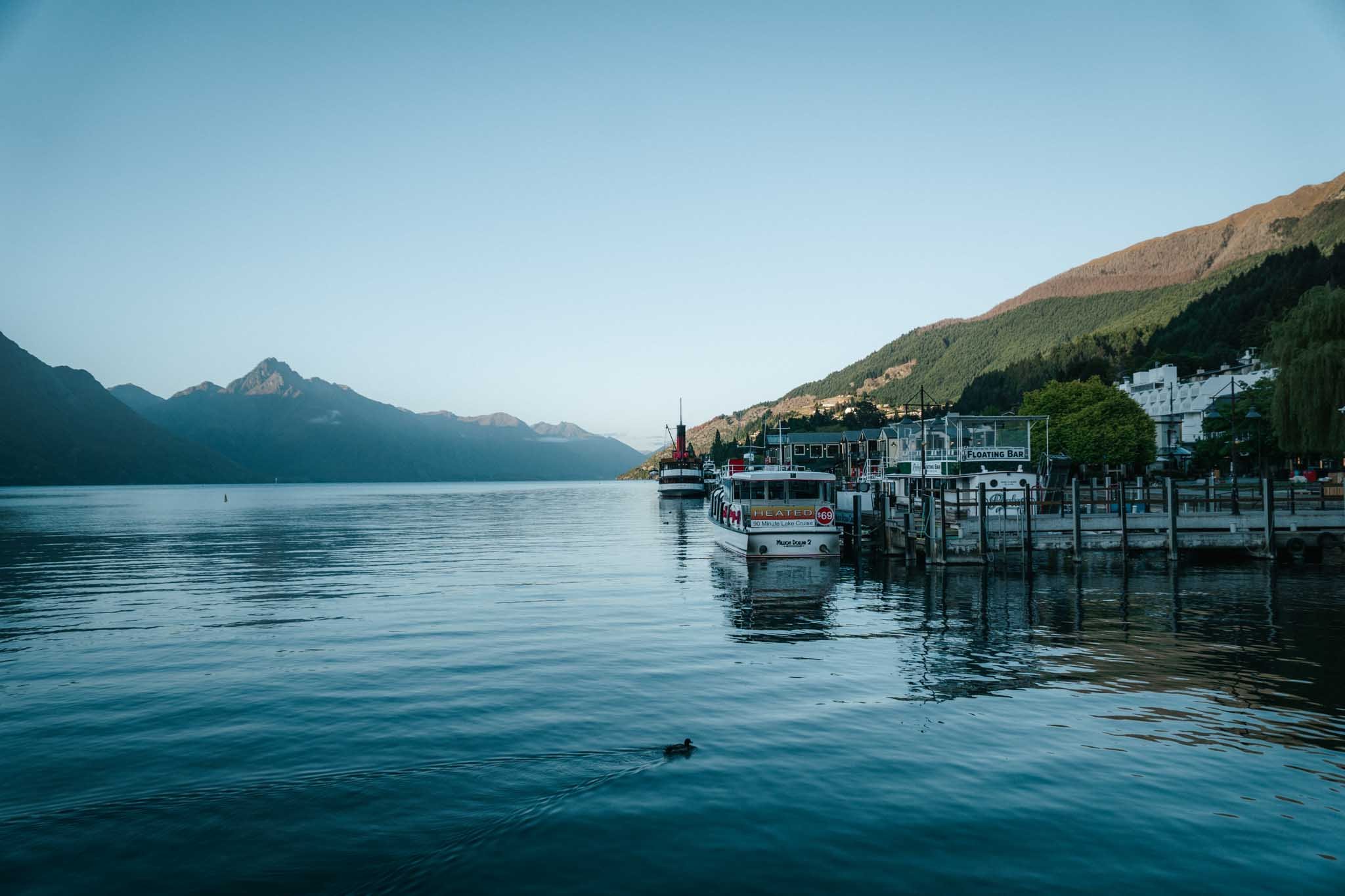An epic two week road trip itinerary for the North and South Islands
Ready for adventure? Here’s how to spend 14 days in New Zealand
ON THE ROAD TO AORAKI/MOUNT COOK
Disclosure: This post has affiliate links, which means if you purchase something through them, I may earn a small commission at no extra cost to you. Thanks for your support.
New Zealand is remote, but our islands are large — all together about the same size as Oregon, and a bit larger than the United Kingdom.
And we have beautiful sights everywhere, on every coast and corner of the two main islands. Which means you’re probably going to need to move a lot. Almost every day, if you want to see the full breadth of what the country has to offer.
This is why New Zealand is such a road trip destination — hopping from one place to the next is the best way to see the country.
If you’re planning on using two precious weeks of holiday time in New Zealand, you have your work cut out planning a trip that covers all the things you want to see.
Driving from Haast to Wanaka, through Mount Aspiring National Park
You could dedicate two weeks to just one island (the North Island if you love beaches, surfing, and Maori culture, or the South Island for epic landscapes and adventure) but if you’re comfortable with a few long driving days, you can cover a lot of New Zealand’s two islands in a two week road trip.
A lot of locals will tell you to slow down and focus on spending more time in one region. In principle I agree with the slow travel approach.
The drive through Lindis Pass, between Queenstown and Aoraki/Mount Cook
But – if this is your once in a lifetime trip to New Zealand, I understand wanting to see as much as you can.
If you don’t mind a couple of longer driving days, I think it’s entirely possible to fit a lot into a short time.
As a New Zealander with a great love for the wildest parts of this country, I’ve had the luxury of spending much more than just 14 days exploring the country. If I had to pack it all into two weeks though, these are the stops I would make along the way.
White Horse Hill Campground, in Aoraki/Mount Cook — if you’re in a campervan, this is an awesome place to camp
14 days in New Zealand
THE BASICS — GETTING AROUND
You’ll need a rental car or a campervan.
For cars, I recommend checking prices on DiscoverCars, and make sure you pick a company which allows you to drop off your vehicle in Rotorua, if you take the internal flight.
The easiest place to compare campervan prices and models is Motorhome Republic — it’s a little clunky but the only alternative is to sift through the campervan websites individually, and they can be even clunkier.
You could look at doing the North Island with a rental car, and the South Island with a campervan, if you want to experience a bit of both.
I have also included an internal flight in this itinerary, to save time. You can travel to Wellington and take the ferry, but this adds several days.
DAY BY DAY ITINERARY
This is a day by day breakdown of two weeks in New Zealand. I’ll go into (a lot) more detail for each day below.
Day 1: Arrive in Auckland and find your feet
Day 2: Take a day trip to Waiheke Island
Day 3: Drive to Rotorua
Day 4: Spend the day exploring Rotorua
Day 5: Fly to Christchurch and spend a night
Day 6: Drive (or take the train) to Hokitika via Arthur’s Pass
Day 7: Drive down the West Coast to Franz Josef
Day 8: Drive from Franz Josef to Wanaka
Day 9: Make your way to Queenstown
Day 10: Take a day trip to Milford Sound
Day 11: Explore more of the area around Queenstown
Day 12: Drive from Queenstown to Aoraki Mount Cook National Park
Day 13: Spend the day exploring Aoraki Mount Cook, before heading to Tekapo for the evening
Day 14: Drive from Lake Tekapo to Christchurch, and fly out
AND A QUICK NOTE ON OPTIONS
I have a lot of different ideas on how you can customise this two week trip to suit you — I have tried to jot down alternatives under ‘itinerary notes.’ I hope it’s not too confusing, and I apologise in advance if by giving you more options I’m just making it harder for you to plan.
Email yourself this itinerary
If you want a copy of this road trip itinerary, drop your email address into this form and I will email it to you as a Google Doc (you will need a Google account for this to work). That way you can avoid having to scroll past ads, and make any notes or edits you like!
Or, get a personalised itinerary
This is just one variation of a two-week New Zealand road trip.
If this itinerary doesn’t look quite right for you, feel free to contact me with questions, or book a call and we can talk through itinerary options together, to help you plan your ideal trip.
Day 1: Arrive into Auckland and find your feet
THE AUCKLAND SKYLINE, SEEN FROM NORTH HEAD
You’re probably going to fly in or out of Auckland at some point. Most international flights land in Auckland Airport, with a handful heading straight to Christchurch or Wellington.
If you want to cover both islands, it’s most likely easiest to start from Auckland and fly back from Christchurch or Queenstown (although you could absolutely do that in reverse — fly south then stop in Auckland for a night before catching your international flight).
Only spend as much time as you need in Auckland. It’s a city, much like cities elsewhere. Find your feet, head to Waiheke, then get out of there.
The airport is at least 30 minutes from the centre of the city (more in rush hour traffic) but even so, I wouldn’t try to stay close to the airport.
There are a few airport hotels if you just want a bed for a night, but there isn’t a great deal around on the dining front, and the general scenery is somewhat industrial. If you head into the city centre, you’ll be able to have a meal at one of the city’s fantastic restaurants and perhaps head for a drink to toast your arrival (I recommend The Churchill, a rooftop bar, if that’s the case).
ITINERARY NOTES
You could do this itinerary in reverse, and catch a flight to Christchurch as soon as you arrive in Auckland. That way, you could reserve a relaxing day on Waiheke Island for the very end of your trip, and spend a night in Auckland before catching your international flight.
If you do spend a night or two in Auckland before setting off, pick up your car or campervan when you plan to leave the city, rather than when you arrive.
Parking is a nightmare and you will probably end up paying for a day or two when you aren’t using the car, for example if you take the ferry across to Waiheke Island.
FEATURED STAY
Hotel Britomart
Independent, with a focus on design and sustainability, Hotel Britomart is in an ideal location and is probably the most unique hotel in all of Auckland.
Day 2: Day trip to Waiheke Island
The lush garden at Mudbrick, where you can sit and smell lavender on the breeze as you look out across the Hauraki Gulf
For your first full day Waiheke Island is an excellent destination.
It’s easy to get there — just catch a 45 minute ferry from the downtown ferry terminal. I recommend taking the Island Direct ferry instead of Fullers, as it’s smaller and less hectic onboard, plus you can book a time slot.
If you’re aiming for vineyards, once on the island the easiest way to get around is to book a wine tour. I recommend going with Kiwi Connect, a small local company, because they like to strike a balance between seeing wineries and scenic places.
Oneroa is the main village on Waiheke, where you can find a few cafes (try Akito) the Island Grocer (for picnic supplies) and restaurants (check out Oyster Inn).
You can also catch public buses around the island, by just tapping on and off with your credit/debit card. They go past many of the more popular vineyards, like Tantalus and Te Motu, so you can visit one or two vineyards (there are several clustered together so you can easily walk between them) and stop for a lavish lunch somewhere.
If the weather is on your side, there are lovely walks and beaches to explore around Waiheke as well.
ITINERARY NOTES
If you don’t fancy wine tasting, you can very easily skip this day and head straight to Rotorua.
Or, if you land in Auckland in the morning, you can very easily catch the ferry to the Island in the afternoon. It really is quick and easy to get across.
Staying around Britomart means you will be easy walking distance to the ferry terminal.
Alternatively, you can also book a night’s accommodation on Waiheke itself, for a beautiful experience (I love staying on Waiheke!).
And as mentioned above — if you fly out of Auckland at the end of your trip, you can always arrange to spend the night before your international flight in the city and make the Waiheke afternoon trip the very last thing you do in New Zealand.
FEATURED EXPERIENCE
‘Far End’ Waiheke Wine Tour
If you like the idea of getting away from the more crowded parts of Waiheke, and seeing arguably the more scenic part of the island, I really enjoyed exploring the ‘Far End’ of Waiheke with Kiwi Connect.
Day 3: Drive to Rotorua and relax in thermal springs
Geothermal steam and Maori carvings in Ohinemutu, Rotorua
Rotorua isn’t the most impressive town. New Zealanders like to call it “Roto-vegas;” I’m not sure why, but it somehow feels appropriate.
What makes Rotorua worth visiting is the impressive geothermal activity and depth of Maori history in the area.
Two nights is enough to take in a geothermal park and some hot pools, with a Maori cultural performance in the evening. If you have longer than two nights (let’s say you skip Waiheke Island), there are plenty of other adventure activities around Rotorua as well — the rivers near Rotorua make for high-adrenaline rafting, and lush native forest is ideal for ziplines.
Ziplining with Rotorua Canopy Tours is a lovely experience
From Auckland, it takes around three hours to drive to Rotorua.
There’s not a great deal along this route, but a small detour will take you to Matamata, and Hobbiton. There you can do the movie set tour. I’ll be honest, I have never once visited Hobbiton; it looks fun, but most of the time I’d rather be exploring the outdoors. I’ll get there one day.
Steam rising from the lakefront at sunrise
Walk around Sulphur Point at sunrise to see the steam catching the light
On your first evening in Rotorua, you can go for a walk around Sulphur Point, where you can see the edge of the lake steaming and bubbling.
Another place to stroll around is Kuirau Park, where you can see simmering mud pools and steam vents. It’s free to enter, and there is even an area where you can enjoy a free foot bath in thermal water.
Kuirau Park in the centre of Rotorua is free to stroll around, and has several geothermal features
If you would prefer to immerse your full body in hot water, you can do that too. The Polynesian Spa in the centre of town is open into the evening, and in my view is even better at night (the pools aren’t shaded, so I don’t think they would be much fun in the sunshine).
Steam billowing from the Polynesian Spa
The lakefront hot pools
As a side note, one place I don’t particularly recommend is Secret Spot hot tubs. They don’t use geothermal water, but heat it themselves, which seems beside the point when you’re in a town where water comes out of the ground boiling.
Another option for natural thermal pools is the hot springs by Lake Rotoiti. These are accessible by water only, so you can go for an evening kayak tour and see glow worms into the bargain. (I haven’t done this trip yet, but I’m dying to go. I love anywhere that isn’t accessible by road).
I have, however, done the evening glow worm kayaking tour with Taiao Adventures, and I loved it.
You might notice in this two-week itinerary that I haven’t mentioned Waitomo Caves, one of the North Island’s main attractions. That’s mostly because it would add quite a lot of driving — Waitomo is a little over two hours from Rotorua.
In case you haven’t heard of Waitomo Caves, that’s the go-to spot for seeing glow worms, and doing all kinds of caving things, like black water rafting and abseiling into holes in the ground. It’s a fun, adventurous place, but there are other opportunities on this itinerary to see glow worms (if the caving part of Waitomo doesn’t appeal to you).
A case in point is kayaking through the glowworm caves on a lake near Rotorua. It’s a pretty unique and beautiful experience, paddling across the lake in the dark, under the stars, then nudging into small caves where the ceilings are lit up by glowworms.
The catch is that tours have to leave after dark, which can be fairly late in summer (in Waitomo, you can visit any time of day because the worms are underground). That means a late night, but it also makes it easy enough to schedule into your itinerary after a day of driving.
ITINERARY NOTES
If you wanted to spend more time in Rotorua, you could skip Waiheke Island and spend the extra night in Rotorua instead.
There’s a lot to do in Rotorua (for all ages — I haven’t even mentioned the luge or other family-friendly activities) so you won’t get bored if you have a bit more time to spend there.
WHERE TO STAY IN ROTORUA
If you’re in a campervan, Orakei Korako offers camping in their carpark for free, if you pay to visit the park. You can park here overnight and visit the park first thing in the morning.
At the Waikite Valley Hot Pools, a similar deal applies — there is a fee for camping, but this includes entry to the hot pools and you even get access to the hot pools before they are open to the general public.
Day 4: Visit one of Rotorua’s geothermal parks, and maybe a Maori village visit in the evening
Rotorua is the place of steaming lakes and cliffs — where mud boils and water comes out of the ground already too hot to touch
With a full day in Rotorua, you can easily visit one of the geothermal parks during the day, followed by a Maori cultural performance in the evening.
Wai O Tapu, where you can see the Champagne Pool, a large turqoise and orange pool, is possibly the most popular geothermal park. That means it is one of the busiest ones.
I prefer Waimangu Volcanic Valley, a slightly quieter option which involves a gentle walk through the valley.
Steaming cliffs at Waimangu Volcanic Valley
In the evening, you can look at visiting one of the Maori villages in Rotorua. These cultural experiences are somewhat commercialised — Te Pa Tu caters to a couple of bus loads of visitors each night — but they do provide a good introduction to traditional Maori customs and food.
Te Pā Tū centres around Māori storytelling, performance, and hākari (feasting). I enjoyed the performances, and the opportunity to explore a ‘village’, even though it’s not a living village per say. The food was just okay, in my opinion, but I don’t eat meat, so maybe I missed out.
FEATURED ACTIVITY
Te Pā Tū
Te Pā Tū provides a decent taster of Maori culture, with a welcome ceremony, canapes in the forest, a multi-course meal, and plenty of kapa haka (singing and performances).
Day 5: Fly from Rotorua to Christchurch
The most time efficient way to see both islands is to fly from Rotorua to Christchurch.
One internal flight in New Zealand can save you hours of driving , and with the cost of petrol and the ferry between the islands, you will end up spending the same amount or less on a flight from north to south.
The only catch is that Rotorua airport is very small and there is a limited number of direct flights to Christchurch.
If timings don’t work, you could head back to Auckland to catch a flight south (there are many more flight times from Auckland, and lower prices too, as the budget airline Jetstar flies out of there).
You could even make a detour to Waitomo Caves on your way back to Auckland, and catch an evening flight south — this makes a nice little trifecta of Hobbiton, Rotorua, and Waitomo, which are three of the top things to see in the North Island.
Christchurch is the largest city in the South Island, which makes it a key entry and exit point. It’s a good place to stop for a night and enjoy the parks, restaurants, and lively city centre.
Go for a stroll around the city centre, and check out the pastel buildings of New Regent Street. Christchurch has some great street art and a cool urban vibe.
To hit the highlights quickly, explore Christchurch on the hop on hop off heritage tram
You can also visit the Botanic Gardens — Cuningham House is beautiful — or go punting on the Avon.
ITINERARY NOTES
If you’re visiting New Zealand for the natural beauty, one afternoon and evening in Christchurch is enough.
You could even skip Christchurch altogether, picking up your vehicle at the airport and heading out of town immediately. To be honest, I often skip straight out of Christchurch — I like the town, but I will always prefer wild places more.
You could make it to Hoktika the same day you land in Christchurch, if you go for an early flight.
If you are campervan curious, one option could be to pick up a campervan in Christchurch and make the South Island part of your trip more of a van life road trip.
That way, you get a mix of both styles of travel in the North and South islands.
WHERE TO EAT IN CHRISTCHURCH
Twenty Seven Steps — an awesome restaurant
Rollickin’ Gelato — make a late night dessert stop here
Grizzly Baked Goods — pick up road trip snacks, or just coffee and pastries for your morning stroll
WHERE TO STAY IN CHRISTCHURCH
$$ — Novotel Christchurch Cathedral Square is right in the middle of town, on the edge of Cathedral Square. I’ve stayed here before and loved being so central. The only thing to note is parking is a nightmare in the middle of the city. I picked up my rental car after leaving this hotel, so I didn’t have to manage parking, but it did mean going back out to the airport.
$ — Last time I was in Christchurch, I stayed at The Bealey Quarter which was perfectly fine — nothing fancy but everything I needed. I also really liked that I could park for free here and walk into the centre, which was around 15 minutes.
FEATURED STAY
Crowne Plaza Christchurch
Set in a tall tower building, this art deco styled hotel has great views of the city — I loved the little window seat in my room.
Day 6: Drive (or train) from Christchurch to Hokitika
Travelling on the TranzAlpine train
From Christchurch, you have the option of taking the train from one side of the South Island to the other. The TranzAlpine train cuts through some incredible mountain scenery.
It does make a nice change from driving — I loved the open air viewing carriage. You can pick up another rental car at the Greymouth train station, and then carry on to Hokitika from there.
I think the TranzAlpine is really only worth it for train enthusiasts, though. The train tracks mostly follow the road, so you don’t see a great deal you wouldn’t see by car. And the cost of a ticket is high.
Travelling in Scenic Plus was a lot of fun (they are not shy about plying passengers with alcohol) and the carriages are beautiful. But, if you spend a lot of time in the viewing carriage, it doesn’t really matter how nice your seat is.
To be clear, I did enjoy the TranzAlpine. I just have such a fondness for road tripping, that it was hard to sail right past beautiful places and not get out and explore.
If you choose to drive across from Christchurch, a lot of people like to stop at Castle Hill, which is a good spot to stretch your legs. But, if you only want to stop in one spot for a walk, I prefer Arthur’s Pass.
Devil’s Punchbowl waterfall in Arthur’s Pass
Arthur’s Pass is a lush, green, often wet stop with keas calling from the low mists. I loved the small former tunneller’s cottages that line the road through the pass.
There’s a nice short walk to the Devil’s Punchbowl waterfalls.
The drive down to the West Coast is incredible and throws into sharp relief the differences in climate between both coasts of the South Island. Leaving the golden, arid plains behind you’ll find yourself in the thick forests of the West Coast.
Hokitika makes a great place to stop for the night. If you’re lucky, you’ll catch a sunset on the driftwood strewn beach.
ITINERARY NOTES
If there has been heavy rain in the previous day or two, you might want to skip Hokitika Gorge. The water won’t be bright blue but a raging torrent of brown if this is the case.
I went right after a few days of downpour and it wasn’t worth the detour, as the blue water is what makes it so special.
You could also choose to spend the night in Arthur’s Pass and stop by Hokitika on the drive to Franz Josef the next day.
I have spent a night at the Mountain House Hostel in Arthur’s Pass before and it was perfect, nothing fancy but right in the village and close to all the walking trails.
Arthur’s Pass has this amazing almost desolate feeling, it seems to rain there almost all the time and the cries of the kea there make it feel haunted. It’s always nice to stay overnight in a national park, so if you want a wilderness experience, it’s certainly something to think about.
Day 8: Head to Franz Josef and glacier country
A guide walking on Franz Josef
WHY GO: Fox and Franz Josef are twin glacier, and both equally impressive. What makes this area so worthwhile, though is also the lush rainforest. This is one of my favourite parts of New Zealand.
HOW MUCH TIME SHOULD YOU SPEND IN FRANZ JOSEF: You could feasibly stop in Franz Josef for only one night, if you wanted to just do one of the walks to a lookout point, or join a heli hike.
If you have the time, though (maybe if you skip staying in Christchurch), staying for two nights is awesome. That gives you a bit more time to explore Fox as well as Franz, and even head out to Okarito.
Visit the Hokitika Gorge in the morning. The loop track is easy and not too long.
After visiting the gorge, start making your way down to glacier country.
Most people opt to stay in Franz Josef, as the town is more set up for tourists. There are more big hotels in Franz, and more options for eating.
Fox Glacier is a smaller town, which feels more like a typical New Zealand village.
No matter where you choose to base yourself, the premier activity here is taking a heli-hike on one of the glaciers.
Both Franz Josef glacier and Fox glacier are equally impressive, and you can easily see both via short walking tracks.
Near Franz:
Franz Josef viewpoint, 30 minutes return. A nice walk, but busy and you’re pretty far from the glacier.
Alex Knob Track, 8 hours return. I think this was my favourite.
Roberts Point Track, 5 hours return. This one gets you closer to the glacier and has cool swing bridges along the way.
Near Fox:
The South Side walkway, 2 hours return. This one is worth doing for the forest views alone.
Mt Fox Route, 8 hours return (but it’s a very rough track). If you want a less travelled route, this one is amazing.
Just check your expectations — there’s a good chance it will be rainy or cloudy and the glaciers will be hiding from view.
This is the wettest part of the country after all.
Even if you can’t see them, enjoy short walks in the area. The forest here is incredible, rich in undergrowth and emerald moss. It has a truly enchanted feel, as if nymphs and fairies are hiding behind every mossy log.
ITINERARY NOTES
If you have an extra day in glacier country, I recommend stopping by Okarito.
It’s one of my favourite places on the West Coast, and it’s hard to explain why. Maybe it’s the white herons that are cast like ghosts in the dark waters of the lagoon, or the sleepy nature of a tiny coastal town.
I think it has something to do with the wild feeling of the place, which is unique as it’s one of the only places where the mountains flow to the sea uninterrupted by human activity.
The Okarito walkway is a stunning walk, and if you loop back along the beach you might see Hector’s Dolphins.
If you have enough time, try kayaking on the lagoon to spot birds.
A WORTHY DETOUR
The short walk around Lake Matheson is stunning, and there’s a roadside lookout nearby where you can see Fox Glacier.
WHERE TO STAY
If you’re in a campervan, I can recommend either the Orange Sheep Campervan Park in Franz Josef, for a beautiful spot tucked into the forest, or Gillespies Beach Campground near Fox Glacier.
FEATURED HOTEL
Legacy Te Waonui Hotel Franz Josef
It’s a more expensive stay, but this hotel has a gorgeous setting in the rainforest. I also really liked the food, both for dinner and breakfast.
Day 8: Drive to Wanaka through Haast Pass and Mount Aspiring National Park
The Wanaka lakefront in lake March was a beautiful explosion of autumn colour
From Franz Josef, it’s almost 4 hours to drive to Wanaka.
Wanaka isn’t that far away from Queenstown (only one hour) but it still makes a good point to break up the drive from the West Coast.
You could push on to Queenstown, but having done that drive before I don’t recommend it. It’s a long day and all I remember is arriving into Queenstown tired and miserable.
Stopping 45 minutes short in Wanaka will give you a little more time to enjoy the drive.
The road cuts through Mount Aspiring National park on the way through Haast Pass, with a number of stunning short walks and lookouts along the way,
Check out the Blue Pools, Fantail Falls, and Wilson’s Creek.
I also love the part of the road where you’re driving along the edge of Lake Wanaka, then take a left and crest a small hill to be greeted with the sight of Lake Hawea.
One night is enough time to see a bit of Wanaka town and a shorter walk nearby.
Wanaka is also a cool town in its own right, with a pretty location right on the lake.
The main draw to Wanaka, though, is the great hiking in the area. Roy’s Peak is the famous walk, but I also love Isthmus Peak, Rocky Mountain, and the walks in the Matukituki Valley.
ITINERARY NOTES
You could skip Wanaka if you’re not big on hiking
The main things to do around Wanaka involve walks and hikes, and generally exploring the outdoors. There are also lake cruises, but you might find that these are a little more impressive in Queenstown.
If you would prefer to be in a more lively town with more activity options, skip Wanaka and spend an extra night in Queenstown.
FEATURED HOTEL
Cross Hill Lodge and Domes
A family-owned glamping stay near Lake Hawea.
Day 9: To Queenstown
The Queenstown lakefront, early morning
WHY GO: Queenstown is a major activity hub in the South Island, being close to Fiordland and Mt Aspiring National Parks. The sheer number of tourist operators and accommodation providers also make Queenstown easy for visitors.
HOW MUCH TIME TO SPEND IN QUEENSTOWN: You want at the very least two nights in Queenstown, to allow for a day trip somewhere in the general area.
Milford Sound is probably the most popular day trip, but hikes around Glenorchy are also amazing. Then there’s the Central Otago wine region, Arrowtown, and places like Skipper’s Canyon.
So, three nights is better, and if you’re very interested in things like bungy jumps and jet boats, you might even want four nights in Queenstown.
The drive from Wanaka to Queenstown takes roughly one hour, and you can choose from two routes.
The first option is to go over the Crown Range Road, past Cardrona and the famous Cardrona Hotel. This is the more scenic route, but the road is smaller and often closed in winter.
The other option is to take the low road through the Kawerau River Gorge, which conveniently takes you past some great wineries in the Gibbston region.
The wine here is spectacular, but obviously if you’re tasing any of the vintages, don’t drive afterwards. The vineyards are also great for food.
Either way, you can also stop in at Arrowtown before getting to Queenstown. Arrowtown is only small, and you can wander round the village in an hour or so before going for food or coffee at a local cafe — check out Provisions of Arrowtown or the Fork and Tap.
By the time you arrive into Queenstown, it will probably be time for you to check in and then you can spend the rest of the afternoon exploring the town or one of the walks nearby.
ITINERARY NOTES
Not long ago I was in a hut on the Greenstone Caples track, and I met an older couple who remember visiting Queenstown back in the 70s.
Back then, they said, it was just a small town.
No Hiltons, no multi-million dollar mansions. Just a town on a lake that happened to have a lot of cool outdoor activities close by.
They were a little shocked at how much things have changed.
If you’re reading this, there’s a good chance you’re like me, and you’re not that interested in the flashy, overly commercial activities on offer in Queenstown.
I’m thinking of things like the Ice Bar, or the Hydro Attack shark boats that do little submarine trips in Lake Wakatipu.
All of this to say that Queenstown is a lot of things, and not all of them are good.
It makes a convenient base, and it is a beautiful setting, but if you want to avoid the flashier parts of Queenstown, I recommend staying outside of the centre. Frankton works, even if it is dominated by strip malls.
FEATURED HOTEL
Stay of Queenstown
Independently owned, perfectly located, and very welcoming.
Day 10: Visit Milford Sound
WHY GO: Milford Sound is located in Fiordland, possibly New Zealand’s greatest wilderness. In terms of spectacular landscape and raw, untamed nature — this is as good as it gets.
Milford is one of New Zealand’s most visited destinations, so there is a whole industry of boats, kayaks, helicopters, and tour buses that grant access to the sound, but it still manages to be incredible.
Milford Sound is a full day trip.
I strongly recommended doing this on a tour from Queenstown, as it’s a solid 4 hour drive each way.
You could easily spend four days exploring all of the stops along the road to Milford Sound, but if you just want to get the highlights in one day, a tour is a good way to do it.
Plus, you won’t have to worry about parking at Milford.
Here are some different options:
If you self drive, I recommend booking a tour with Cruise Milford; they are a small boat operator and the only family run cruise company in Milford.
If you like the idea of small groups, this small bus tour/cruise from Queenstown might suit you. It’s run by Cheeky Kiwi Travel but they partner with Cruise Milford. The tour includes lunch and snacks.
If the idea of sitting in a bus for eight hours in a single day doesn’t appeal, you could treat yourself to a Fly Cruise Fly option, which gets you there and back much faster.
ITINERARY NOTES
Milford Sound is a pretty spectacular place, but as always I encourage you to weigh up if it’s worth your time — you don’t need to do it just because everyone says you should.
I am a case in point. It took me years and many visits to Queenstown before I first went to Milford, and I never felt like I was missing out. There are just so many other places to spend time.
It is a very long day trip, so you may want to prioritise spending your time closer to Queenstown.
Driving to Glenorchy is spectacular and there are some great hikes around there (if you’re fit, you can get up to Harris Saddle on the Routeburn Track, if you’re less fit even getting to Routeburn Flats Hut is nice) so that can make an excellent alternative to Milford Sound.
Alternatively, you could consider driving from Wanaka to Te Anau, which means you’re only a two hour drive from Milford Sound the next day. You could then drive back to Queenstown after visiting Milford Sound.
Day 11: Explore more of the area around Queenstown
There’s so much to do around Queenstown — and it’s so pretty — that I think it’s worth staying another full day there.
You can take advantage of one of the many day trip options around Queenstown, or just pick an activity closer to town and have a slower day.
One of my favourite things to do in Queenstown is hike up Ben Lomond, a trail that starts from town (or the top of the gondola — do this), and takes you to incredible views with just a couple of hours hiking.
For hiking, there is also, Glenorchy a small village around 45 minutes from Queenstown, on the edge of Lake Wakatipu. There’s not much to do in the town itself — it’s the setting that’s worthwhile.
Drive out towards the the Routeburn Shelter (the Glenorchy end of the Routeburn Track) and you’ll travel across the braided river flowing into Lake Wakatipu near Glenorchy. It’s spectacular.
From the Routeburn Shelter, you can walk in to Routeburn Flats hut, or as far as Routeburn Falls. If you’re up for one big day hike, you could even carry on to Harris Saddle.
If you’d rather spend more time on the river than hiking the trails, one of the coolest day trips you can do from Queenstown is a funyak tour in Mount Aspiring National Park, just beyond Glenorchy. Jet boat up the Dart River, and then kayak back down in the inflatable ‘funyaks.’
If you don’t plan on doing any long hikes, this is one of the best ways to see some of the incredible scenery, and bright blue water, of Mount Aspiring (my favourite national park).
Another Queenstown activity I loved — but did not expect to enjoy — was cruising across Lake Wakatipu on the TSS Earnslaw. The coal-fired steamship sails over to Walter Peak station, where we had a gourmet buffet dinner (surprisingly good) and then watched a sheep dog show (spectacular).
I thought the whole experience would be a little cheesy, but it wasn’t. The ship is a nice piece of history, with incredible views of the lake (try and time it so you’re catching sunset on the way over) and the combination of dinner and a dog show was awesome.
ACTIVITY HIGHLIGHT
Funyaking on the Dart River
Paddling down a river on an inflatable kayak is a fun way to see Mount Aspiring National Park near Queenstown.
Day 12: Queenstown to Aoraki/Mount Cook National Park (or Twizel)
Driving through Lindis Pass
From Queenstown to Twizel is around 2.5 hours; it’s 3.5 hours to drive all the way to Aoraki/Mount Cook.
Whether you drive all the way there depends on whether you manage to find accommodation in the park.
There are hotels and places to stay in Aoraki/Mount Cook Village, but rooms book out way in advance. You’ll need to book as much as a year in advance if you want to travel during the busy summer period.
The DOC campground in the park is a great option if you’re in a campervan. It’s magical staying somewhere so remote and beautiful and waking up to the bowl of mountains.
If you miss out on rooms in Mount Cook Village, you can search for accommodation in Twizel instead. Twizel itself isn’t special, but it’s conveniently located less than an hour from Mount Cook, and there are great places to eat (check out Mint Folk & Co), petrol stations, and supermarkets.
There isn’t a great deal to do in Twizel, so if this is where you do end up staying, I would aim to arrive in the evening, spending more time en route, then set off to the national park first thing in the morning.
On your way out of Queenstown, stop by Black Lab Coffee in Country Lane to fuel up for the drive.
If you’re leaving later, and not in a rush, you could stop by a vineyard or two on your way through the Kawerau Valley. I love Mt Rosa for a relaxed platter and glass of wine; the outdoor area there is beautiful.
Another possible lunch stop is the Tarras Country Cafe, a quaint little spot in the middle of nowhere. They do a few New Zealand classics, like cheese rolls and lolly cake.
After that, the road will take you through Lindis Pass, which is beautiful, and down into Omarama. If you’re only going as far as Twizel, you might have time to visit the Omarama Clay Cliffs.
If you’re driving all the way to Mount Cook, the road reaches a new level of spectacular once you hit Lakr Pukaki.
The drive along the edge of the lake is surreal on a good day; there are superb viewpoints of the mountains ahead. The shimmering spire of Aoraki/Mount Cook, New Zealand’s highest mountain, rises above the far end of the lake, a truly wonderful scene.
FEATURED STAY
Aoraki Alpine Lodge
A basic but very serviceable place to stay, with a great shared kitchen and lounge area. With almost nowhere to eat in the park, having cooking facilities was perfect.
Day 13: Explore Aoraki Mount Cook National Park, before making your way to Tekapo
Aoraki/Mount Cook — the cloud piercer — is New Zealand’s highest peak.
The national park lying at the foot of Aoraki is quite possibly the single most beautiful place in New Zealand, a land of rock and ice. The sound of rock and ice falls is almost always present, and even in summer ice bergs drift in the glacial lake below Aoraki.
For somewhere so wildly and dramatically beautiful place, Aoraki/Mount Cook National Park is surprisingly accessible.
There are a handful of short walks suitable for all abilities. (Although it’s worth noting that this easy accessibility and stunning scenery together make Mount Cook a very busy place).
If you can’t find a place to stay in the park (and in summer, it’s likely you will not) a day trip is enough to walk one of the trails in the park, and maybe go on the glacial boat tour.
The Hooker Valley Track (currently closed, but opening again in 2026) is three hours return, while the longer Sealy Tarns track is around five hours return.
If you do manage to find accommodation in the park, you might want to stay two nights to make the most of it. The mornings and evenings, when the day tripper crowds have gone, are magical.
You can walk the Hooker Valley Track in the afternoon, or if you prefer to be on the track when there are fewer people around set your alarm for early the next morning.
If you go early, you have a good chance of having the hike to yourself.
Driving along the shore of Lake Pukaki, towards Aoraki
Day 14: Tekapo to Christchurch
WHY GO: Lake Tekapo makes a convenient place to stop after visiting Aoraki/Mount Cook. It’s also very pretty, with a nice lake and alpine views.
HOW MUCH TIME DO YOU NEED IN TEKAPO: I honestly think an evening and a morning, or even a few hours, is enough for Tekapo.
The night skies there are famously clear, perfect for going on a stargazing tour, but other than that you don’t need a lot of time in Tekapo.
You only need as long as it takes you to stroll around the lakefront, with a visit to Astro Cafe and the Mount John Observatory as well.
I honestly find the Tekapo lakefront a little scruffy, and there are always a lot of people crowded around the tiny Church of the Good Shepherd.
That said, I love the drive between Lake Pukaki and Lake Tekapo — you’ll have the Southern Alps on your left, so on clear days the views on the drive are stunning.
In the evening, you may want to take a stargazing tour if the weather is on your side.
In the morning, you can head up to the Mount Saint John Observatory to enjoy views and coffee at Astro Cafe (just note it costs $8 to drive up to the observatory — walking up is free).
It’s a 3 hours drive from Tekapo to Christchurch, which will likely take a lot longer by the time you factor in stops.
Burke’s Pass is a curious place to stop and examine trinkets and signage from days gone by, while Fairlie is a locally famous road trip stop —you can’t leave town without stopping by the Fairlie Bakehouse for a pie, a New Zealand favourite.
If you arrive into Christchurch in the late afternoon or evening, you can drop off your hire car and enjoy a nice meal for your final evening.
Your final day will probably be a travel one, but you can spend the morning taking in one last coffee shop in Christchurch.
If you want to browse for souvenirs, I recommend checking out Hapa in The Tannery — they have lots of beautiful local designs and gifts.
An alternative would be to fly back to Auckland on the evening of day 13, and spend your final night there before catching your international flight the next day.
I do think Auckland has more splurge type restaurants and bars than Christchurch, so it depends how you want to wrap up your trip.
ITINERARY NOTES
You don’t necessarily need to fly back to Auckland (or out of the country) from Christchurch.
Lake Tekapo is roughly halfway between Queenstown and Christchurch, so you could backtrack to the Queenstown airport if there was a more convenient flight from that airport.
More New Zealand itineraries
There are many, many different combinations of destinations for a two week trip around New Zealand.
Here are a few other itineraries I have crafted, to give you a sense of alternative routes:
Thank you for reading
You being here is what makes my life as a travel writer possible, so thank you. I hope this has been helpful and you have come away with a better idea of what a two week trip in New Zealand might look like
All of the photos and words (and spelling mistakes and other errors) on this page are mine, created without help from either AI or other humans.
My goal is to try and make sure your travels around New Zealand are the best they can be, in exchange for your support. Reading my posts, clicking my links, sharing with your friends; all of this helps me keep doing what I’m doing.
So, thank you again, and while you’re here, maybe take a look at a few other articles:
AUTHOR BIO
I’m a freelance travel writer from New Zealand with bylines in National Geographic Travel, Conde Nast Traveler, Travel + Leisure and more.
I’ve travelled up and down beautiful Aotearoa and I love sharing my recommendations for the best places to visit in New Zealand.
This post was about:
READ MORE:







